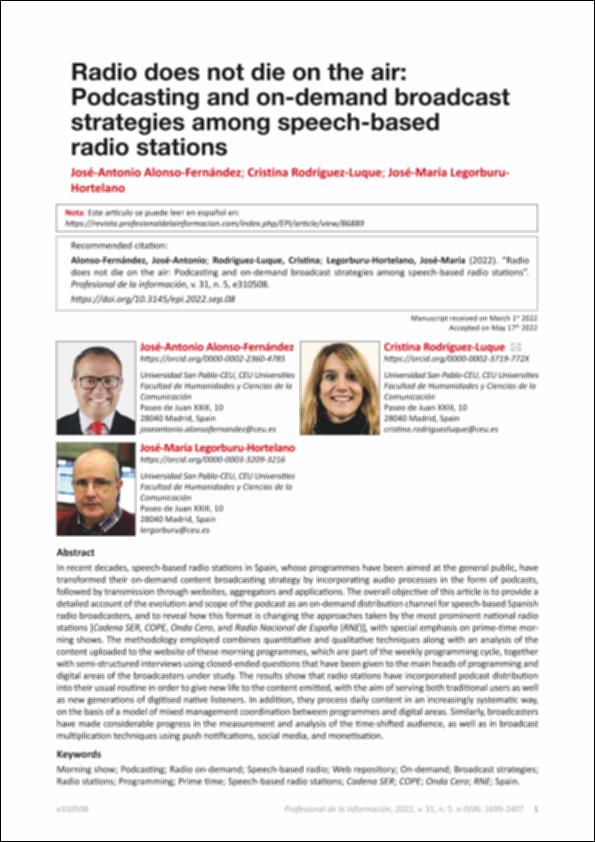Please use this identifier to cite or link to this item:
http://hdl.handle.net/10637/14700Radio does not die on the air: Podcasting and on-demand broadcast strategies among speech-based radio stations
| Title: | Radio does not die on the air: Podcasting and on-demand broadcast strategies among speech-based radio stations La radio no muere en la antena. Podcastingy estrategias de difusión a la carta en emisoras generalistas |
| Authors : | Alonso Fernández, José Antonio Rodríguez Luque, Cristina Legorburu Hortelano, José María |
| Keywords: | Morning show; Podcasting; Radio on-demand; Speech-based radio; Web repository; On-demand; Broadcast strategies; Radio stations; Programming; Prime time; Speech-based radio stations |
| Publisher: | EPI SCP |
| Citation: | Alonso-Fernández, J.-A., Rodríguez-Luque, C., & Legorburu-Hortelano, J.-M. . (2022). Radio does not die on the air: Podcasting and on-demand broadcast strategies among speech-based radio stations. Profesional De La información Information Professional, 31(5). https://doi.org/10.3145/epi.2022.sep.08 |
| Abstract: | In recent decades, speech-based radio stations in Spain, whose programmes have been aimed at the general public, have transformed their on-demand content broadcasting strategy by incorporating audio processes in the form of podcasts, followed by transmission through websites, aggregators and applications. The overall objective of this article is to provide a detailed account of the evolution and scope of the podcast as an on-demand distribution channel for speech-based Spanish radio broadcasters, and to reveal how this format is changing the approaches taken by the most prominent national radio stations [Cadena SER, COPE, Onda Cero, and Radio Nacional de España (RNE)], with special emphasis on prime-time morning shows. The methodology employed combines quantitative and qualitative techniques along with an analysis of the
content uploaded to the website of these morning programmes, which are part of the weekly programming cycle, together with semi-structured interviews using closed-ended questions that have been given to the main heads of programming and digital areas of the broadcasters under study. The results show that radio stations have incorporated podcast distribution into their usual routine in order to give new life to the content emitted, with the aim of serving both traditional users as well as new generations of digitised native listeners. In addition, they process daily content in an increasingly systematic way, on the basis of a model of mixed management coordination between programmes and digital areas. Similarly, broadcasters have made considerable progress in the measurement and analysis of the time-shifted audience, as well as in broadcast
multiplication techniques using push notifications, social media, and monetisation. Las cadenas españolas de radio generalista han transformado en las últimas décadas su estrategia de difusión de con-tenido a la carta, incorporando el procesado de audios en formato pódcast y su difusión a través de webs, agregadores y aplicaciones. El presente artículo tiene como objetivo general conocer en detalle la evolución y el alcance del pódcast como vía de distribución bajo demanda por la radio generalista y se plantea saber cómo este formato está modificando los planteamientos de las principales cadenas nacionales –Cadena SER, COPE, Onda Cero y Radio Nacional de España (RNE)–, con especial atención a los magacines matinales, sus programas de mayor audiencia. La metodología utilizada combina técnicas cuantitativas y cualitativas con un análisis de contenido de la puesta en página de los magacines mati-nales del ciclo de programación semanal; junto con entrevistas semiestructuradas bajo cuestionario cerrado a los prin-cipales responsables de programación y de las áreas digitales de las emisoras estudiadas. Los resultados evidencian que las cadenas han incorporado la distribución vía pódcast a sus rutinas habituales para dar una segunda vida a los conteni-dos emitidos, con el fin de atender tanto los usuarios tradicionales como a las nuevas generaciones de oyentes nativos digitales. Además, procesan de una forma cada vez más sistemática los contenidos diarios, conforme a un modelo de gestión mixto de coordinación entre los programas y las áreas digitales. De la misma manera, las emisoras han avanzado considerablemente en la medición y el análisis de la audiencia en diferido, así como en las técnicas de multiplicación de la difusión mediante el uso de alertas y redes sociales; y en la monetización. |
| Description: | Este artículo se puede leer en español en: https://revista.profesionaldelainformacion.com/index.php/EPI/article/view/86889 |
| URI: | http://hdl.handle.net/10637/14700 |
| Rights : | http://creativecommons.org/licenses/by-nc-nd/4.0/deed.es |
| ISSN: | 1699-2407 |
| Issue Date: | 2022 |
| Center : | Universidad San Pablo-CEU |
| Appears in Collections: | Facultad de Humanidades y CC de la Comunicación |
Items in DSpace are protected by copyright, with all rights reserved, unless otherwise indicated.


